Research Plan for Accounting: Assessing 20-Hour Work Week Effects
VerifiedAdded on 2021/05/30
|14
|3429
|34
Report
AI Summary
This report presents a research plan focused on the impact of a 20-hour work week on an organization. The research aims to assess the advantages, challenges, and client reactions to this work arrangement. It employs a qualitative approach, collecting data through interviews, observations, and document reviews from staff and clients. The plan outlines the selection of participants, data collection methods, and analysis techniques, including deconstruction, interpretation, and reconstruction. The report also addresses potential limitations of the findings and explores participatory budgeting, examining its definition, sources, and impact on government accountability and transparency. The report is based on the specifics of a case organization, with the goal of improving customer service while maintaining reduced working hours. The research plan also discusses the importance of participatory budgeting and reviews relevant literature on the topic, highlighting how it can improve government transparency and citizen engagement.
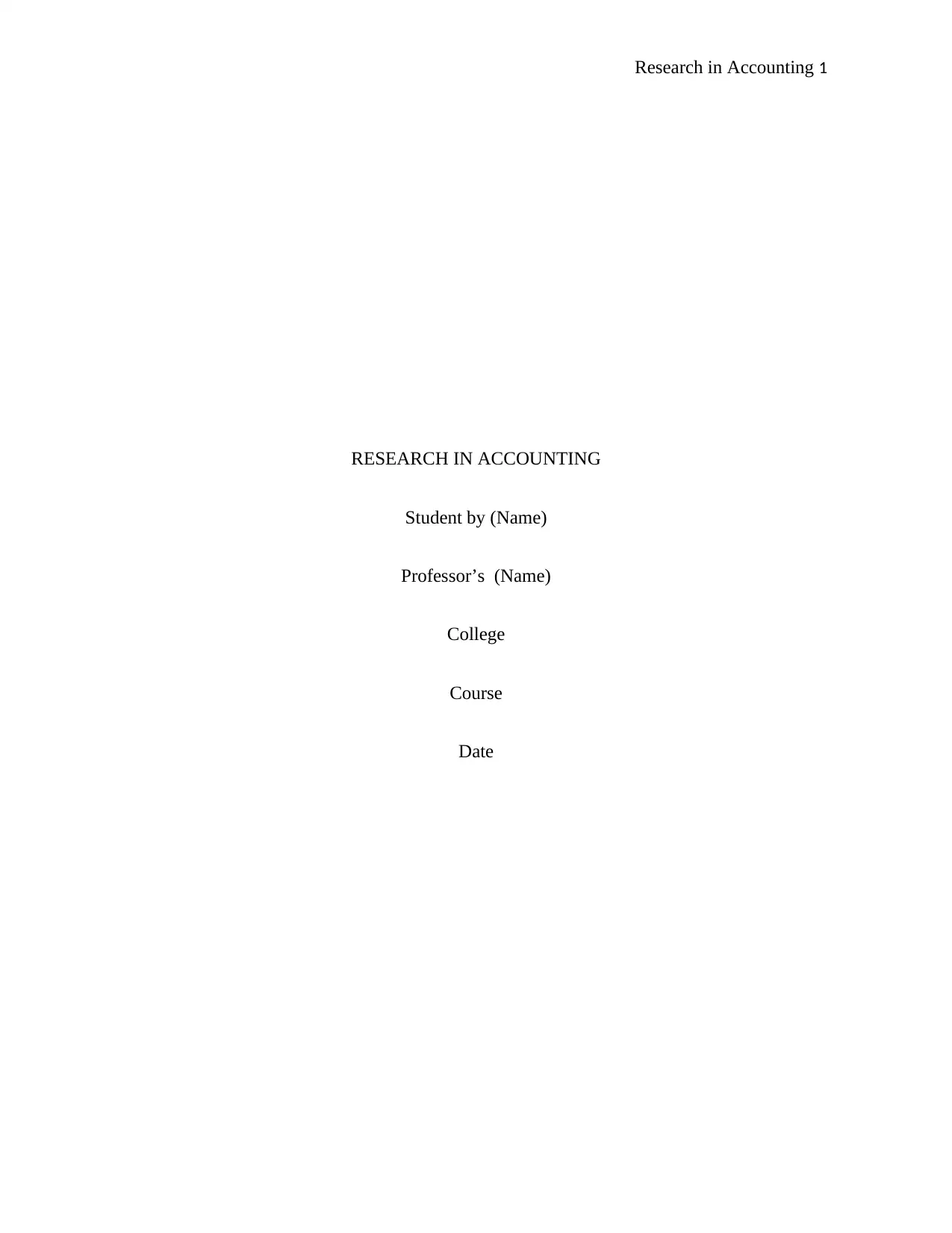
Research in Accounting 1
RESEARCH IN ACCOUNTING
Student by (Name)
Professor’s (Name)
College
Course
Date
RESEARCH IN ACCOUNTING
Student by (Name)
Professor’s (Name)
College
Course
Date
Paraphrase This Document
Need a fresh take? Get an instant paraphrase of this document with our AI Paraphraser
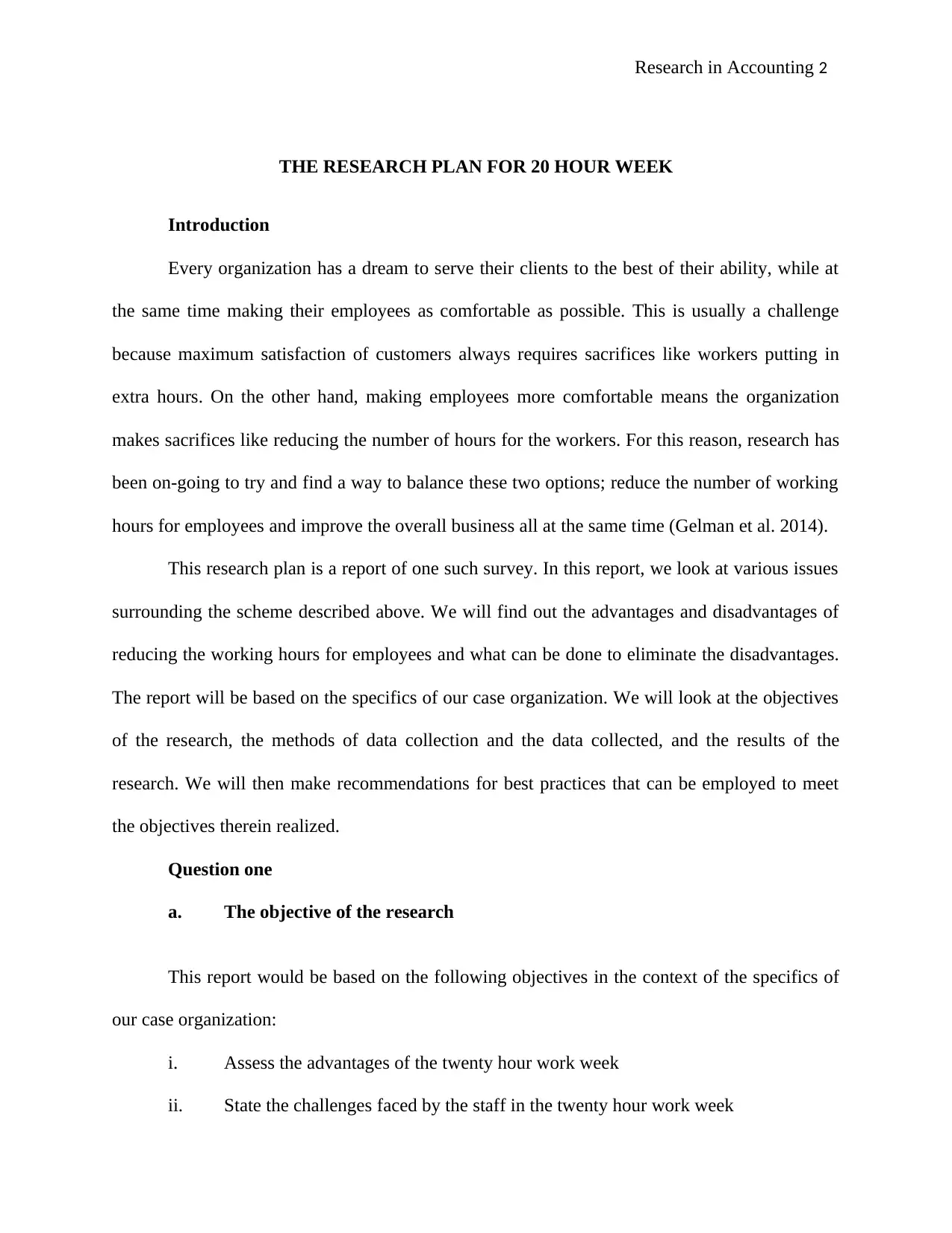
Research in Accounting 2
THE RESEARCH PLAN FOR 20 HOUR WEEK
Introduction
Every organization has a dream to serve their clients to the best of their ability, while at
the same time making their employees as comfortable as possible. This is usually a challenge
because maximum satisfaction of customers always requires sacrifices like workers putting in
extra hours. On the other hand, making employees more comfortable means the organization
makes sacrifices like reducing the number of hours for the workers. For this reason, research has
been on-going to try and find a way to balance these two options; reduce the number of working
hours for employees and improve the overall business all at the same time (Gelman et al. 2014).
This research plan is a report of one such survey. In this report, we look at various issues
surrounding the scheme described above. We will find out the advantages and disadvantages of
reducing the working hours for employees and what can be done to eliminate the disadvantages.
The report will be based on the specifics of our case organization. We will look at the objectives
of the research, the methods of data collection and the data collected, and the results of the
research. We will then make recommendations for best practices that can be employed to meet
the objectives therein realized.
Question one
a. The objective of the research
This report would be based on the following objectives in the context of the specifics of
our case organization:
i. Assess the advantages of the twenty hour work week
ii. State the challenges faced by the staff in the twenty hour work week
THE RESEARCH PLAN FOR 20 HOUR WEEK
Introduction
Every organization has a dream to serve their clients to the best of their ability, while at
the same time making their employees as comfortable as possible. This is usually a challenge
because maximum satisfaction of customers always requires sacrifices like workers putting in
extra hours. On the other hand, making employees more comfortable means the organization
makes sacrifices like reducing the number of hours for the workers. For this reason, research has
been on-going to try and find a way to balance these two options; reduce the number of working
hours for employees and improve the overall business all at the same time (Gelman et al. 2014).
This research plan is a report of one such survey. In this report, we look at various issues
surrounding the scheme described above. We will find out the advantages and disadvantages of
reducing the working hours for employees and what can be done to eliminate the disadvantages.
The report will be based on the specifics of our case organization. We will look at the objectives
of the research, the methods of data collection and the data collected, and the results of the
research. We will then make recommendations for best practices that can be employed to meet
the objectives therein realized.
Question one
a. The objective of the research
This report would be based on the following objectives in the context of the specifics of
our case organization:
i. Assess the advantages of the twenty hour work week
ii. State the challenges faced by the staff in the twenty hour work week
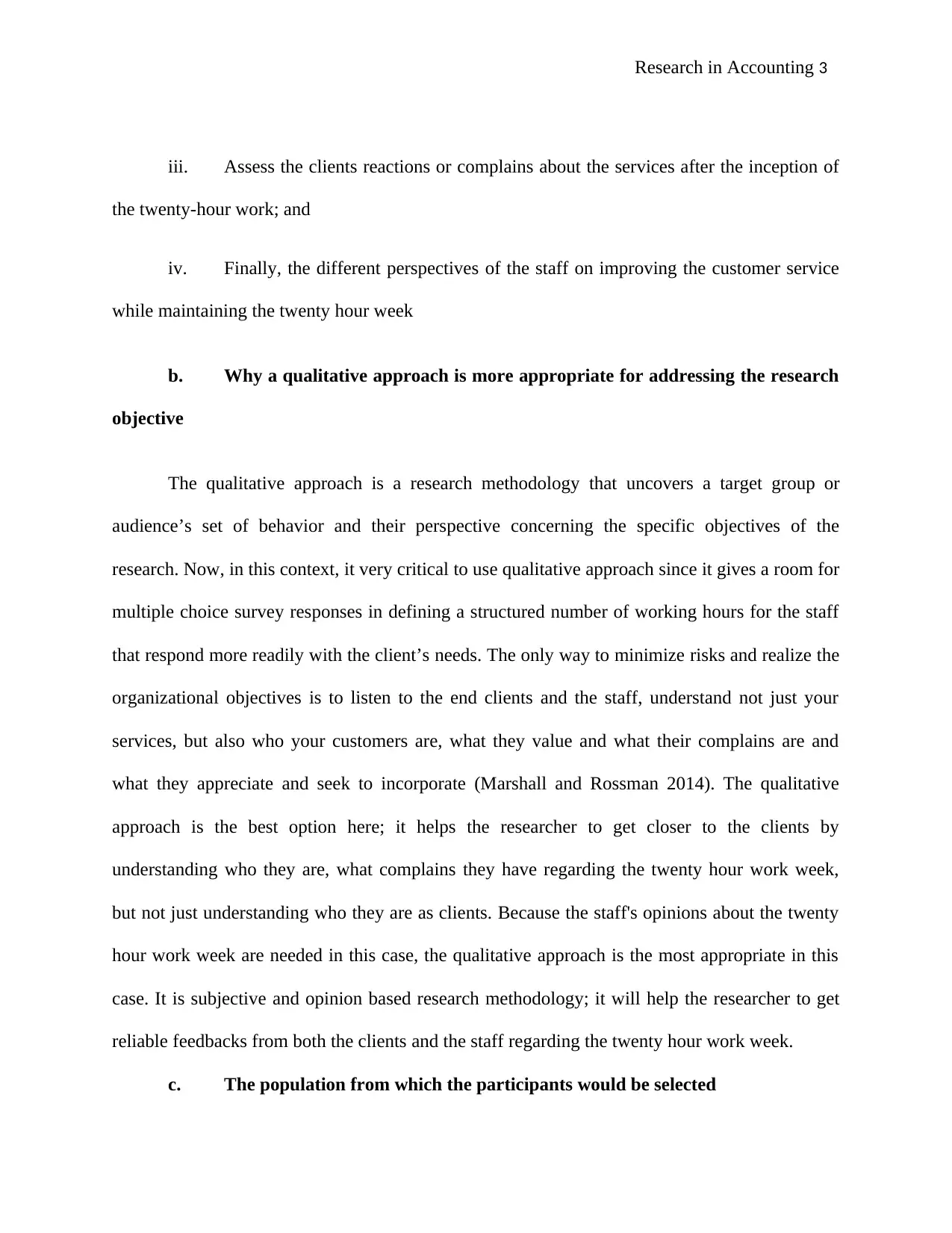
Research in Accounting 3
iii. Assess the clients reactions or complains about the services after the inception of
the twenty-hour work; and
iv. Finally, the different perspectives of the staff on improving the customer service
while maintaining the twenty hour week
b. Why a qualitative approach is more appropriate for addressing the research
objective
The qualitative approach is a research methodology that uncovers a target group or
audience’s set of behavior and their perspective concerning the specific objectives of the
research. Now, in this context, it very critical to use qualitative approach since it gives a room for
multiple choice survey responses in defining a structured number of working hours for the staff
that respond more readily with the client’s needs. The only way to minimize risks and realize the
organizational objectives is to listen to the end clients and the staff, understand not just your
services, but also who your customers are, what they value and what their complains are and
what they appreciate and seek to incorporate (Marshall and Rossman 2014). The qualitative
approach is the best option here; it helps the researcher to get closer to the clients by
understanding who they are, what complains they have regarding the twenty hour work week,
but not just understanding who they are as clients. Because the staff's opinions about the twenty
hour work week are needed in this case, the qualitative approach is the most appropriate in this
case. It is subjective and opinion based research methodology; it will help the researcher to get
reliable feedbacks from both the clients and the staff regarding the twenty hour work week.
c. The population from which the participants would be selected
iii. Assess the clients reactions or complains about the services after the inception of
the twenty-hour work; and
iv. Finally, the different perspectives of the staff on improving the customer service
while maintaining the twenty hour week
b. Why a qualitative approach is more appropriate for addressing the research
objective
The qualitative approach is a research methodology that uncovers a target group or
audience’s set of behavior and their perspective concerning the specific objectives of the
research. Now, in this context, it very critical to use qualitative approach since it gives a room for
multiple choice survey responses in defining a structured number of working hours for the staff
that respond more readily with the client’s needs. The only way to minimize risks and realize the
organizational objectives is to listen to the end clients and the staff, understand not just your
services, but also who your customers are, what they value and what their complains are and
what they appreciate and seek to incorporate (Marshall and Rossman 2014). The qualitative
approach is the best option here; it helps the researcher to get closer to the clients by
understanding who they are, what complains they have regarding the twenty hour work week,
but not just understanding who they are as clients. Because the staff's opinions about the twenty
hour work week are needed in this case, the qualitative approach is the most appropriate in this
case. It is subjective and opinion based research methodology; it will help the researcher to get
reliable feedbacks from both the clients and the staff regarding the twenty hour work week.
c. The population from which the participants would be selected
⊘ This is a preview!⊘
Do you want full access?
Subscribe today to unlock all pages.

Trusted by 1+ million students worldwide
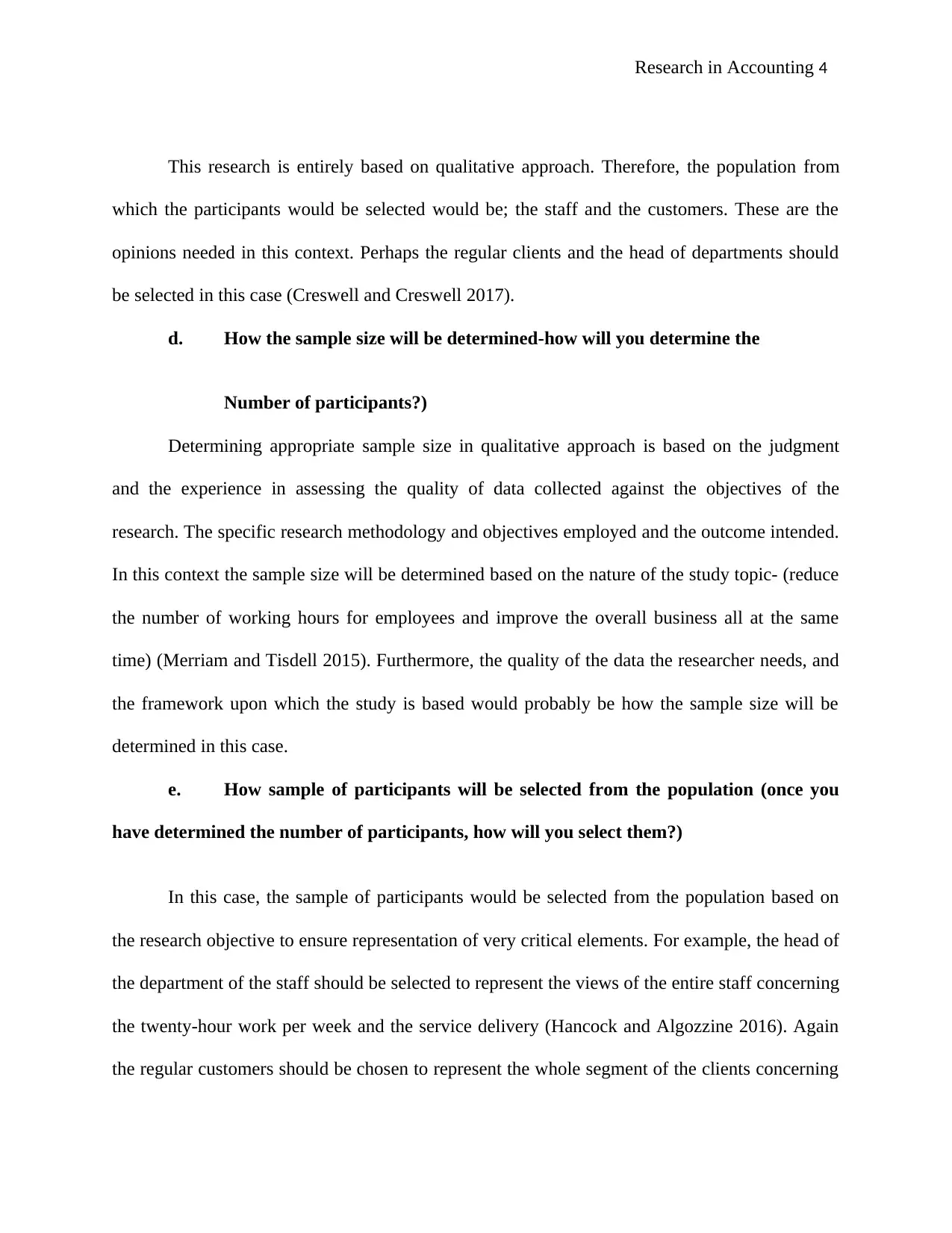
Research in Accounting 4
This research is entirely based on qualitative approach. Therefore, the population from
which the participants would be selected would be; the staff and the customers. These are the
opinions needed in this context. Perhaps the regular clients and the head of departments should
be selected in this case (Creswell and Creswell 2017).
d. How the sample size will be determined-how will you determine the
Number of participants?)
Determining appropriate sample size in qualitative approach is based on the judgment
and the experience in assessing the quality of data collected against the objectives of the
research. The specific research methodology and objectives employed and the outcome intended.
In this context the sample size will be determined based on the nature of the study topic- (reduce
the number of working hours for employees and improve the overall business all at the same
time) (Merriam and Tisdell 2015). Furthermore, the quality of the data the researcher needs, and
the framework upon which the study is based would probably be how the sample size will be
determined in this case.
e. How sample of participants will be selected from the population (once you
have determined the number of participants, how will you select them?)
In this case, the sample of participants would be selected from the population based on
the research objective to ensure representation of very critical elements. For example, the head of
the department of the staff should be selected to represent the views of the entire staff concerning
the twenty-hour work per week and the service delivery (Hancock and Algozzine 2016). Again
the regular customers should be chosen to represent the whole segment of the clients concerning
This research is entirely based on qualitative approach. Therefore, the population from
which the participants would be selected would be; the staff and the customers. These are the
opinions needed in this context. Perhaps the regular clients and the head of departments should
be selected in this case (Creswell and Creswell 2017).
d. How the sample size will be determined-how will you determine the
Number of participants?)
Determining appropriate sample size in qualitative approach is based on the judgment
and the experience in assessing the quality of data collected against the objectives of the
research. The specific research methodology and objectives employed and the outcome intended.
In this context the sample size will be determined based on the nature of the study topic- (reduce
the number of working hours for employees and improve the overall business all at the same
time) (Merriam and Tisdell 2015). Furthermore, the quality of the data the researcher needs, and
the framework upon which the study is based would probably be how the sample size will be
determined in this case.
e. How sample of participants will be selected from the population (once you
have determined the number of participants, how will you select them?)
In this case, the sample of participants would be selected from the population based on
the research objective to ensure representation of very critical elements. For example, the head of
the department of the staff should be selected to represent the views of the entire staff concerning
the twenty-hour work per week and the service delivery (Hancock and Algozzine 2016). Again
the regular customers should be chosen to represent the whole segment of the clients concerning
Paraphrase This Document
Need a fresh take? Get an instant paraphrase of this document with our AI Paraphraser
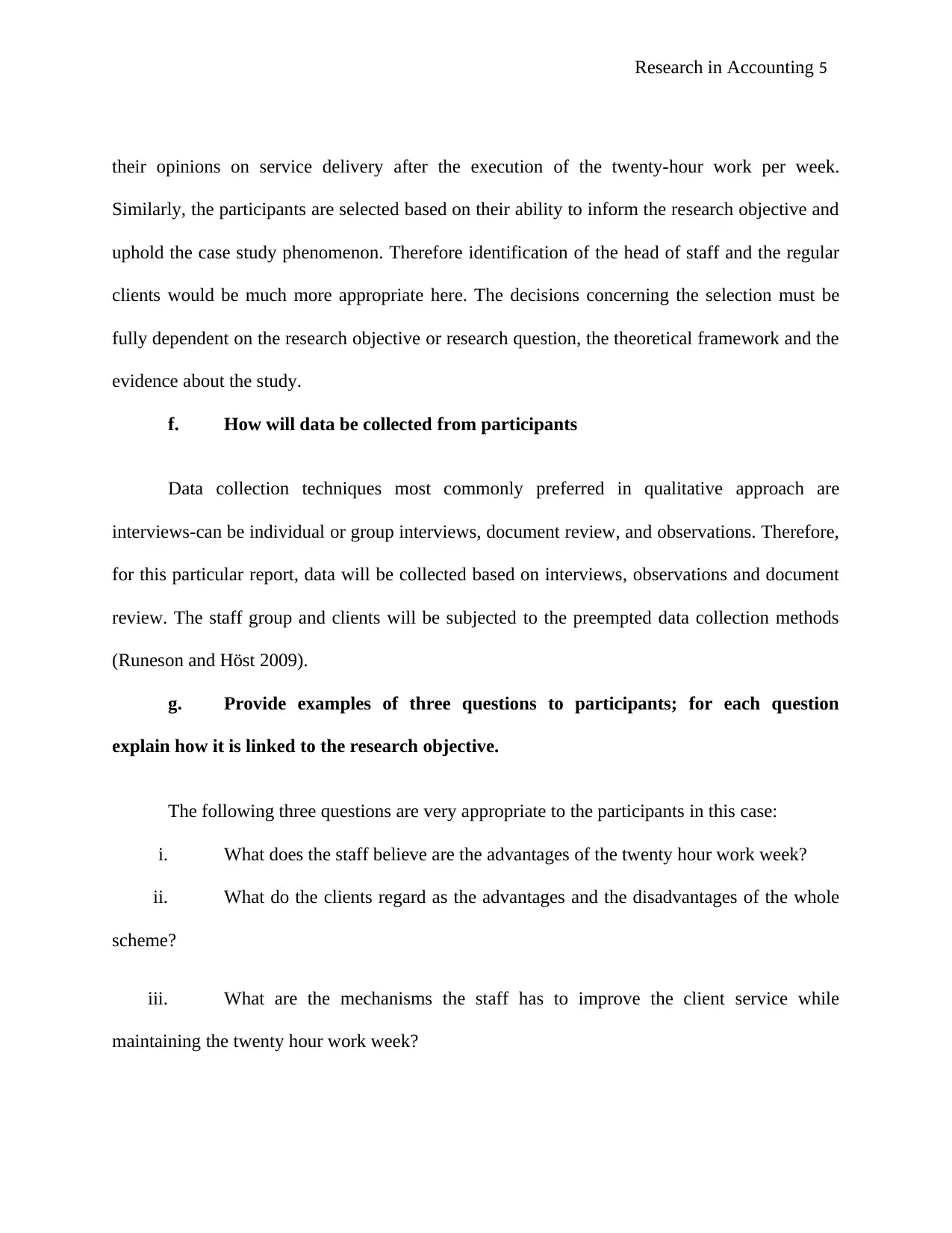
Research in Accounting 5
their opinions on service delivery after the execution of the twenty-hour work per week.
Similarly, the participants are selected based on their ability to inform the research objective and
uphold the case study phenomenon. Therefore identification of the head of staff and the regular
clients would be much more appropriate here. The decisions concerning the selection must be
fully dependent on the research objective or research question, the theoretical framework and the
evidence about the study.
f. How will data be collected from participants
Data collection techniques most commonly preferred in qualitative approach are
interviews-can be individual or group interviews, document review, and observations. Therefore,
for this particular report, data will be collected based on interviews, observations and document
review. The staff group and clients will be subjected to the preempted data collection methods
(Runeson and Höst 2009).
g. Provide examples of three questions to participants; for each question
explain how it is linked to the research objective.
The following three questions are very appropriate to the participants in this case:
i. What does the staff believe are the advantages of the twenty hour work week?
ii. What do the clients regard as the advantages and the disadvantages of the whole
scheme?
iii. What are the mechanisms the staff has to improve the client service while
maintaining the twenty hour work week?
their opinions on service delivery after the execution of the twenty-hour work per week.
Similarly, the participants are selected based on their ability to inform the research objective and
uphold the case study phenomenon. Therefore identification of the head of staff and the regular
clients would be much more appropriate here. The decisions concerning the selection must be
fully dependent on the research objective or research question, the theoretical framework and the
evidence about the study.
f. How will data be collected from participants
Data collection techniques most commonly preferred in qualitative approach are
interviews-can be individual or group interviews, document review, and observations. Therefore,
for this particular report, data will be collected based on interviews, observations and document
review. The staff group and clients will be subjected to the preempted data collection methods
(Runeson and Höst 2009).
g. Provide examples of three questions to participants; for each question
explain how it is linked to the research objective.
The following three questions are very appropriate to the participants in this case:
i. What does the staff believe are the advantages of the twenty hour work week?
ii. What do the clients regard as the advantages and the disadvantages of the whole
scheme?
iii. What are the mechanisms the staff has to improve the client service while
maintaining the twenty hour work week?
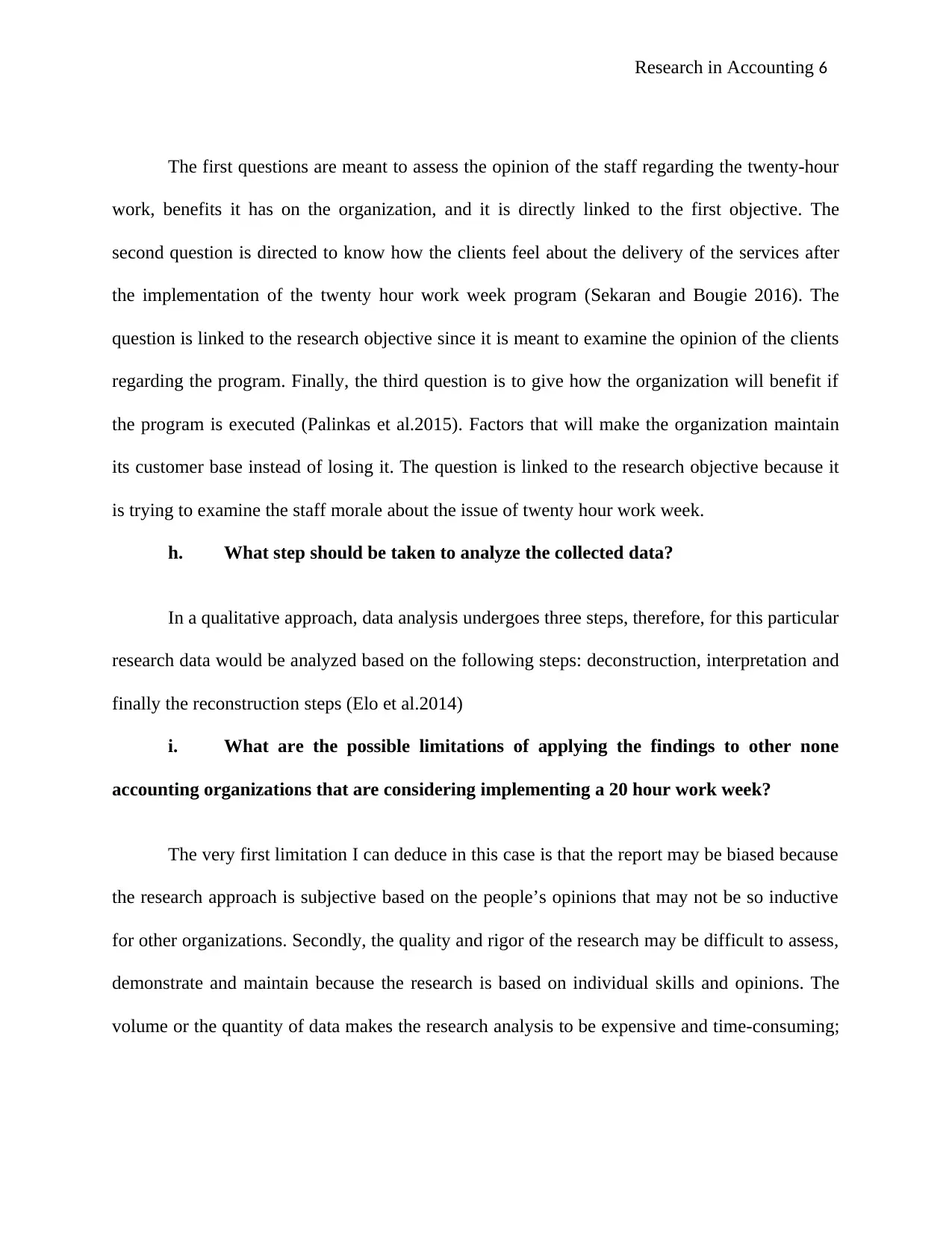
Research in Accounting 6
The first questions are meant to assess the opinion of the staff regarding the twenty-hour
work, benefits it has on the organization, and it is directly linked to the first objective. The
second question is directed to know how the clients feel about the delivery of the services after
the implementation of the twenty hour work week program (Sekaran and Bougie 2016). The
question is linked to the research objective since it is meant to examine the opinion of the clients
regarding the program. Finally, the third question is to give how the organization will benefit if
the program is executed (Palinkas et al.2015). Factors that will make the organization maintain
its customer base instead of losing it. The question is linked to the research objective because it
is trying to examine the staff morale about the issue of twenty hour work week.
h. What step should be taken to analyze the collected data?
In a qualitative approach, data analysis undergoes three steps, therefore, for this particular
research data would be analyzed based on the following steps: deconstruction, interpretation and
finally the reconstruction steps (Elo et al.2014)
i. What are the possible limitations of applying the findings to other none
accounting organizations that are considering implementing a 20 hour work week?
The very first limitation I can deduce in this case is that the report may be biased because
the research approach is subjective based on the people’s opinions that may not be so inductive
for other organizations. Secondly, the quality and rigor of the research may be difficult to assess,
demonstrate and maintain because the research is based on individual skills and opinions. The
volume or the quantity of data makes the research analysis to be expensive and time-consuming;
The first questions are meant to assess the opinion of the staff regarding the twenty-hour
work, benefits it has on the organization, and it is directly linked to the first objective. The
second question is directed to know how the clients feel about the delivery of the services after
the implementation of the twenty hour work week program (Sekaran and Bougie 2016). The
question is linked to the research objective since it is meant to examine the opinion of the clients
regarding the program. Finally, the third question is to give how the organization will benefit if
the program is executed (Palinkas et al.2015). Factors that will make the organization maintain
its customer base instead of losing it. The question is linked to the research objective because it
is trying to examine the staff morale about the issue of twenty hour work week.
h. What step should be taken to analyze the collected data?
In a qualitative approach, data analysis undergoes three steps, therefore, for this particular
research data would be analyzed based on the following steps: deconstruction, interpretation and
finally the reconstruction steps (Elo et al.2014)
i. What are the possible limitations of applying the findings to other none
accounting organizations that are considering implementing a 20 hour work week?
The very first limitation I can deduce in this case is that the report may be biased because
the research approach is subjective based on the people’s opinions that may not be so inductive
for other organizations. Secondly, the quality and rigor of the research may be difficult to assess,
demonstrate and maintain because the research is based on individual skills and opinions. The
volume or the quantity of data makes the research analysis to be expensive and time-consuming;
⊘ This is a preview!⊘
Do you want full access?
Subscribe today to unlock all pages.

Trusted by 1+ million students worldwide
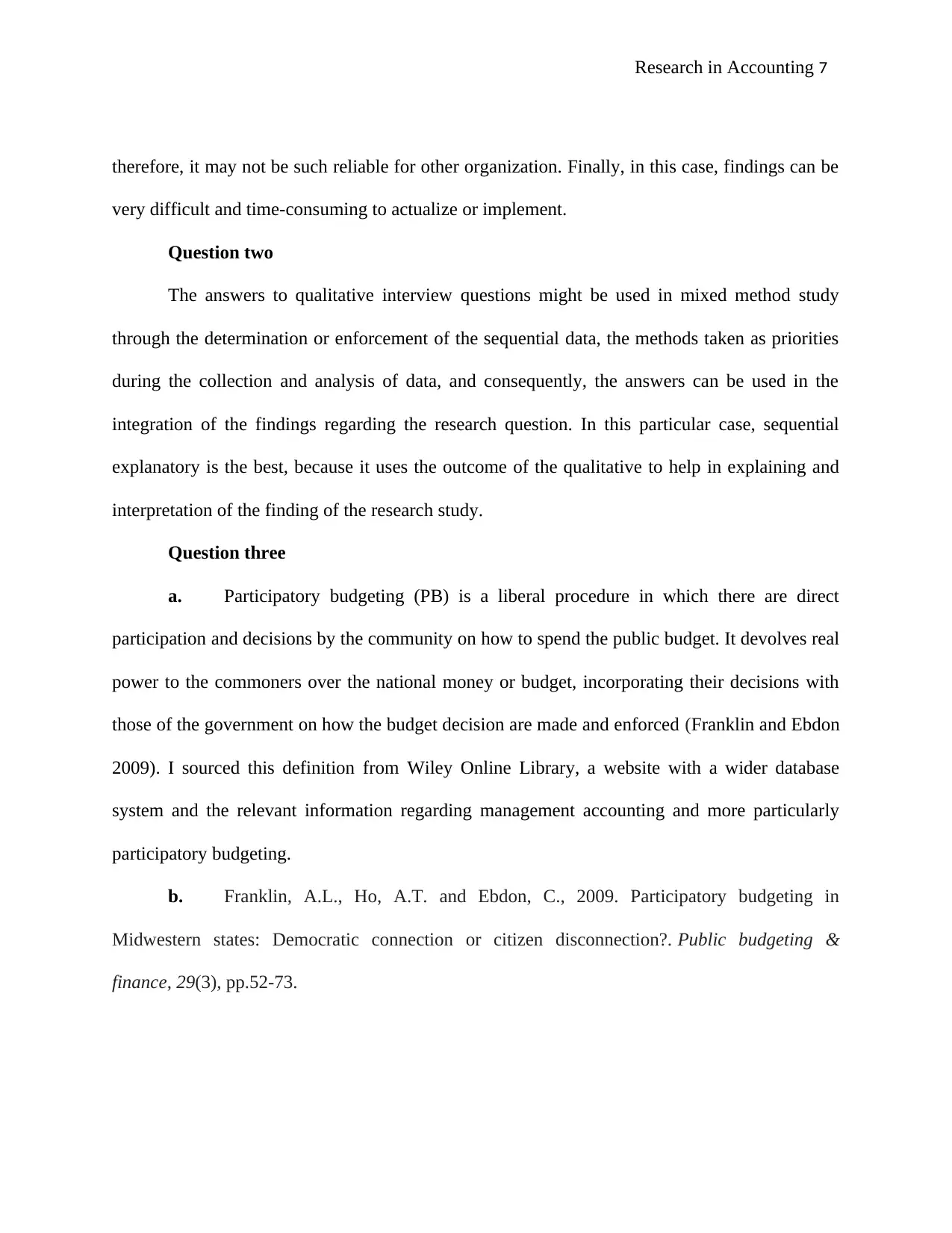
Research in Accounting 7
therefore, it may not be such reliable for other organization. Finally, in this case, findings can be
very difficult and time-consuming to actualize or implement.
Question two
The answers to qualitative interview questions might be used in mixed method study
through the determination or enforcement of the sequential data, the methods taken as priorities
during the collection and analysis of data, and consequently, the answers can be used in the
integration of the findings regarding the research question. In this particular case, sequential
explanatory is the best, because it uses the outcome of the qualitative to help in explaining and
interpretation of the finding of the research study.
Question three
a. Participatory budgeting (PB) is a liberal procedure in which there are direct
participation and decisions by the community on how to spend the public budget. It devolves real
power to the commoners over the national money or budget, incorporating their decisions with
those of the government on how the budget decision are made and enforced (Franklin and Ebdon
2009). I sourced this definition from Wiley Online Library, a website with a wider database
system and the relevant information regarding management accounting and more particularly
participatory budgeting.
b. Franklin, A.L., Ho, A.T. and Ebdon, C., 2009. Participatory budgeting in
Midwestern states: Democratic connection or citizen disconnection?. Public budgeting &
finance, 29(3), pp.52-73.
therefore, it may not be such reliable for other organization. Finally, in this case, findings can be
very difficult and time-consuming to actualize or implement.
Question two
The answers to qualitative interview questions might be used in mixed method study
through the determination or enforcement of the sequential data, the methods taken as priorities
during the collection and analysis of data, and consequently, the answers can be used in the
integration of the findings regarding the research question. In this particular case, sequential
explanatory is the best, because it uses the outcome of the qualitative to help in explaining and
interpretation of the finding of the research study.
Question three
a. Participatory budgeting (PB) is a liberal procedure in which there are direct
participation and decisions by the community on how to spend the public budget. It devolves real
power to the commoners over the national money or budget, incorporating their decisions with
those of the government on how the budget decision are made and enforced (Franklin and Ebdon
2009). I sourced this definition from Wiley Online Library, a website with a wider database
system and the relevant information regarding management accounting and more particularly
participatory budgeting.
b. Franklin, A.L., Ho, A.T. and Ebdon, C., 2009. Participatory budgeting in
Midwestern states: Democratic connection or citizen disconnection?. Public budgeting &
finance, 29(3), pp.52-73.
Paraphrase This Document
Need a fresh take? Get an instant paraphrase of this document with our AI Paraphraser
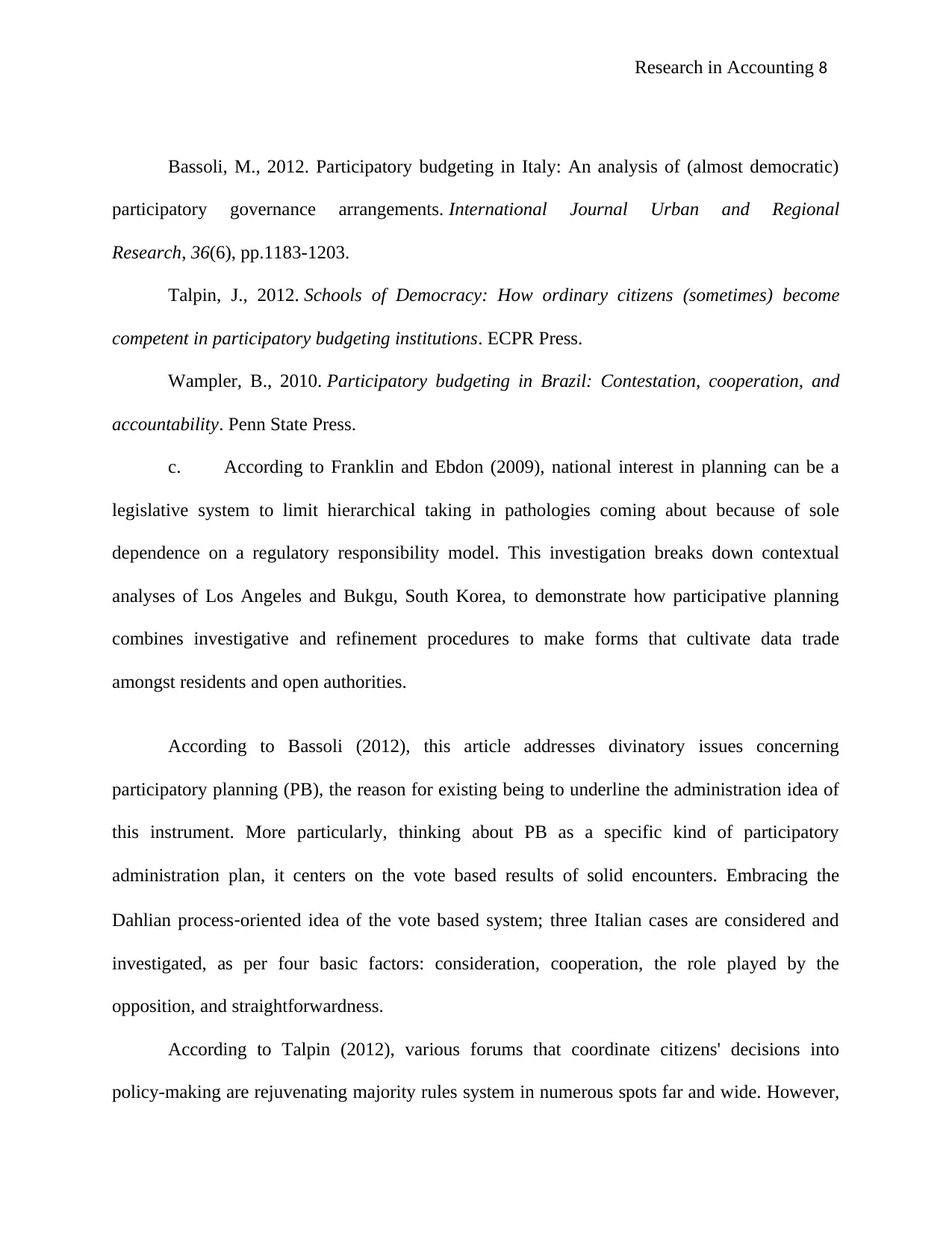
Research in Accounting 8
Bassoli, M., 2012. Participatory budgeting in Italy: An analysis of (almost democratic)
participatory governance arrangements. International Journal Urban and Regional
Research, 36(6), pp.1183-1203.
Talpin, J., 2012. Schools of Democracy: How ordinary citizens (sometimes) become
competent in participatory budgeting institutions. ECPR Press.
Wampler, B., 2010. Participatory budgeting in Brazil: Contestation, cooperation, and
accountability. Penn State Press.
c. According to Franklin and Ebdon (2009), national interest in planning can be a
legislative system to limit hierarchical taking in pathologies coming about because of sole
dependence on a regulatory responsibility model. This investigation breaks down contextual
analyses of Los Angeles and Bukgu, South Korea, to demonstrate how participative planning
combines investigative and refinement procedures to make forms that cultivate data trade
amongst residents and open authorities.
According to Bassoli (2012), this article addresses divinatory issues concerning
participatory planning (PB), the reason for existing being to underline the administration idea of
this instrument. More particularly, thinking about PB as a specific kind of participatory
administration plan, it centers on the vote based results of solid encounters. Embracing the
Dahlian process‐oriented idea of the vote based system; three Italian cases are considered and
investigated, as per four basic factors: consideration, cooperation, the role played by the
opposition, and straightforwardness.
According to Talpin (2012), various forums that coordinate citizens' decisions into
policy-making are rejuvenating majority rules system in numerous spots far and wide. However,
Bassoli, M., 2012. Participatory budgeting in Italy: An analysis of (almost democratic)
participatory governance arrangements. International Journal Urban and Regional
Research, 36(6), pp.1183-1203.
Talpin, J., 2012. Schools of Democracy: How ordinary citizens (sometimes) become
competent in participatory budgeting institutions. ECPR Press.
Wampler, B., 2010. Participatory budgeting in Brazil: Contestation, cooperation, and
accountability. Penn State Press.
c. According to Franklin and Ebdon (2009), national interest in planning can be a
legislative system to limit hierarchical taking in pathologies coming about because of sole
dependence on a regulatory responsibility model. This investigation breaks down contextual
analyses of Los Angeles and Bukgu, South Korea, to demonstrate how participative planning
combines investigative and refinement procedures to make forms that cultivate data trade
amongst residents and open authorities.
According to Bassoli (2012), this article addresses divinatory issues concerning
participatory planning (PB), the reason for existing being to underline the administration idea of
this instrument. More particularly, thinking about PB as a specific kind of participatory
administration plan, it centers on the vote based results of solid encounters. Embracing the
Dahlian process‐oriented idea of the vote based system; three Italian cases are considered and
investigated, as per four basic factors: consideration, cooperation, the role played by the
opposition, and straightforwardness.
According to Talpin (2012), various forums that coordinate citizens' decisions into
policy-making are rejuvenating majority rules system in numerous spots far and wide. However,

Research in Accounting 9
debate flourishes about whether these forums should be viewed as valid wellsprings of general
conclusion and how they should fit with existing political organizations. By what means can
metro discussions incorporate less effective subjects and guarantee that their points of view are
heard on measure up to terms with more advantaged natives, authorities, and strategy specialists?
By what method can these delicate organizations impart nationals' strategy inclinations
adequately and genuinely to whatever is left of the political framework?
According to Wampler (2010), in this first thorough comparative study of the
phenomenon, he draws evidence from eight regions in Brazil to demonstrate the differing
degrees of achievement and disappointment PB has encountered. He distinguishes why some PB
programs have improved the situation than others in accomplishing the twin objectives of
guaranteeing administrative responsibility and empowering citizenship rights for the poor
residents of these urban communities in the journey for more prominent social equity and a well-
working vote based system.
d. The most prominent, finding in these four articles is based on how participatory
budgeting improves accountability and the overall transparency of the government by devolving
budgeting process to the local citizens (Talpin. 2012). These aspects empower citizens to engage
actively on the roles of their communities and help them comprehend the challenges associated
with the local governance, the cost of the various project for the public, and the nature of trade-
offs the government is likely to consider first (Bassoli 2012). And finally, Brian Wampler (2010)
asserts that PB programs have improved the situation than others in accomplishing the twin
objectives of guaranteeing administrative responsibility and empowering citizenship rights for
debate flourishes about whether these forums should be viewed as valid wellsprings of general
conclusion and how they should fit with existing political organizations. By what means can
metro discussions incorporate less effective subjects and guarantee that their points of view are
heard on measure up to terms with more advantaged natives, authorities, and strategy specialists?
By what method can these delicate organizations impart nationals' strategy inclinations
adequately and genuinely to whatever is left of the political framework?
According to Wampler (2010), in this first thorough comparative study of the
phenomenon, he draws evidence from eight regions in Brazil to demonstrate the differing
degrees of achievement and disappointment PB has encountered. He distinguishes why some PB
programs have improved the situation than others in accomplishing the twin objectives of
guaranteeing administrative responsibility and empowering citizenship rights for the poor
residents of these urban communities in the journey for more prominent social equity and a well-
working vote based system.
d. The most prominent, finding in these four articles is based on how participatory
budgeting improves accountability and the overall transparency of the government by devolving
budgeting process to the local citizens (Talpin. 2012). These aspects empower citizens to engage
actively on the roles of their communities and help them comprehend the challenges associated
with the local governance, the cost of the various project for the public, and the nature of trade-
offs the government is likely to consider first (Bassoli 2012). And finally, Brian Wampler (2010)
asserts that PB programs have improved the situation than others in accomplishing the twin
objectives of guaranteeing administrative responsibility and empowering citizenship rights for
⊘ This is a preview!⊘
Do you want full access?
Subscribe today to unlock all pages.

Trusted by 1+ million students worldwide

Research in Accounting 10
the poor residents of these urban communities in the journey for more prominent social equity
and a well-working vote based system.
e. The Hofstede power distance portrays inequality that is hierarchical, usually
defined from the bottom to the top. In fact, this is the degree to which the societies and various
organizations embrace power differentials. The societies with huge power are categorized based
on the following attributes; autocracy in leadership, authority centralization, paternalistic
management, hierarchy levels. In contrast, the societies with small powers are considered to be;
having consultative management, decentralization o0f decision making et cetera (Hofstede and
Bond 1984). Consequently, individualism culture is seen as; fostering contractual friendships
that are based on the critical aspects of the exchange. They assess the possibility of either the
profit and loss margins before engaging.
f. Researchers suggest that the aspects of national culture, influencing the general
behavior values and attitudes of the individuals must be considered because this usually impacts
of the superior evaluative style during participatory budgeting. (Somboon and Aiyeku 2013).
g. The following are the three major factors influencing participation in budgeting;
i. Decentralization factors; whereby, is associated with tokenism and
nonparticipation in the budget formulation. Perhaps education is the major aspect of the
effectiveness of the public participation in the budget formulation.
ii. Socio-economic factors; education is one of the major socio-economic factor
influencing the participation in budgeting. Gender, age, and level of income do not majorly
influence the participation in budgeting.
the poor residents of these urban communities in the journey for more prominent social equity
and a well-working vote based system.
e. The Hofstede power distance portrays inequality that is hierarchical, usually
defined from the bottom to the top. In fact, this is the degree to which the societies and various
organizations embrace power differentials. The societies with huge power are categorized based
on the following attributes; autocracy in leadership, authority centralization, paternalistic
management, hierarchy levels. In contrast, the societies with small powers are considered to be;
having consultative management, decentralization o0f decision making et cetera (Hofstede and
Bond 1984). Consequently, individualism culture is seen as; fostering contractual friendships
that are based on the critical aspects of the exchange. They assess the possibility of either the
profit and loss margins before engaging.
f. Researchers suggest that the aspects of national culture, influencing the general
behavior values and attitudes of the individuals must be considered because this usually impacts
of the superior evaluative style during participatory budgeting. (Somboon and Aiyeku 2013).
g. The following are the three major factors influencing participation in budgeting;
i. Decentralization factors; whereby, is associated with tokenism and
nonparticipation in the budget formulation. Perhaps education is the major aspect of the
effectiveness of the public participation in the budget formulation.
ii. Socio-economic factors; education is one of the major socio-economic factor
influencing the participation in budgeting. Gender, age, and level of income do not majorly
influence the participation in budgeting.
Paraphrase This Document
Need a fresh take? Get an instant paraphrase of this document with our AI Paraphraser
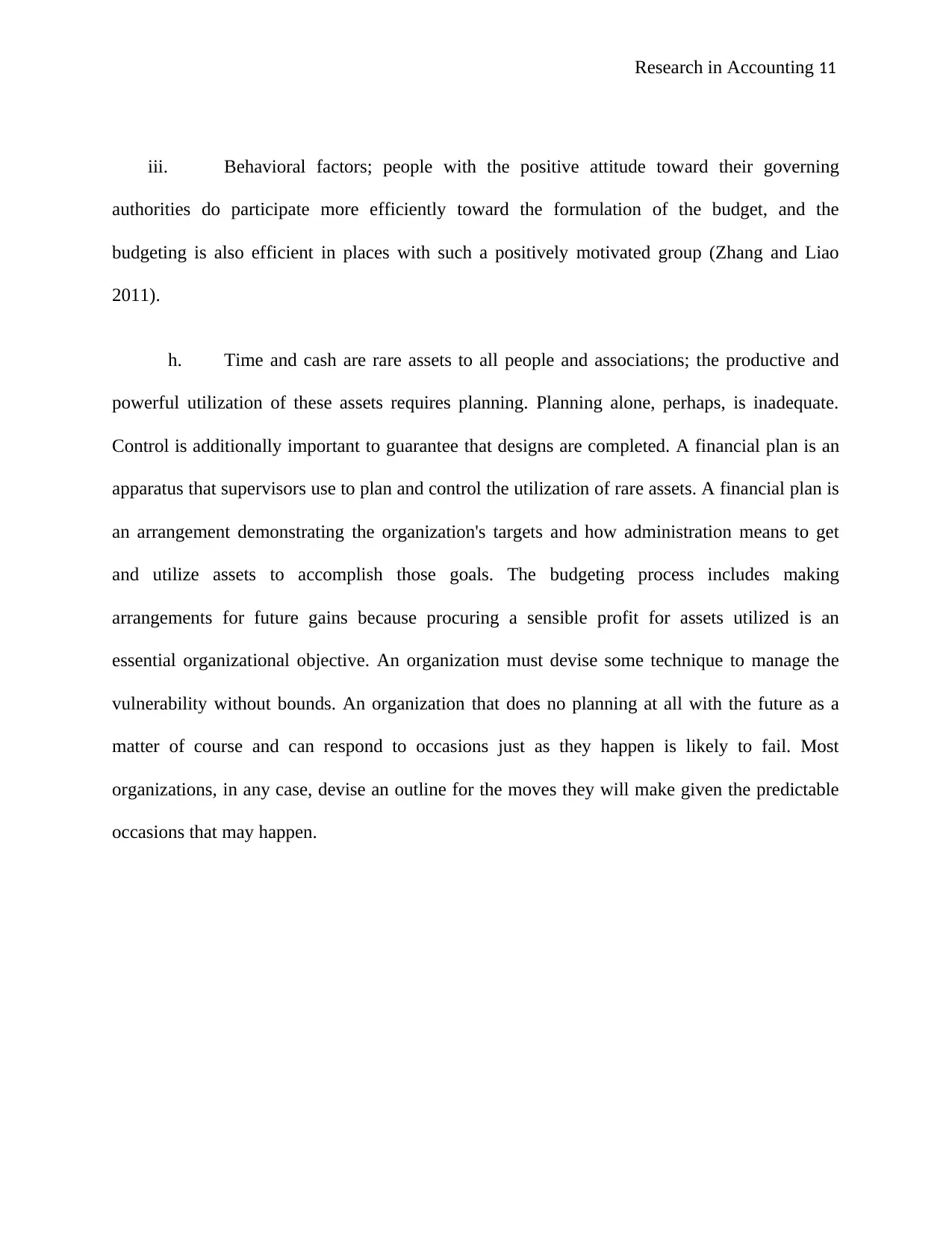
Research in Accounting 11
iii. Behavioral factors; people with the positive attitude toward their governing
authorities do participate more efficiently toward the formulation of the budget, and the
budgeting is also efficient in places with such a positively motivated group (Zhang and Liao
2011).
h. Time and cash are rare assets to all people and associations; the productive and
powerful utilization of these assets requires planning. Planning alone, perhaps, is inadequate.
Control is additionally important to guarantee that designs are completed. A financial plan is an
apparatus that supervisors use to plan and control the utilization of rare assets. A financial plan is
an arrangement demonstrating the organization's targets and how administration means to get
and utilize assets to accomplish those goals. The budgeting process includes making
arrangements for future gains because procuring a sensible profit for assets utilized is an
essential organizational objective. An organization must devise some technique to manage the
vulnerability without bounds. An organization that does no planning at all with the future as a
matter of course and can respond to occasions just as they happen is likely to fail. Most
organizations, in any case, devise an outline for the moves they will make given the predictable
occasions that may happen.
iii. Behavioral factors; people with the positive attitude toward their governing
authorities do participate more efficiently toward the formulation of the budget, and the
budgeting is also efficient in places with such a positively motivated group (Zhang and Liao
2011).
h. Time and cash are rare assets to all people and associations; the productive and
powerful utilization of these assets requires planning. Planning alone, perhaps, is inadequate.
Control is additionally important to guarantee that designs are completed. A financial plan is an
apparatus that supervisors use to plan and control the utilization of rare assets. A financial plan is
an arrangement demonstrating the organization's targets and how administration means to get
and utilize assets to accomplish those goals. The budgeting process includes making
arrangements for future gains because procuring a sensible profit for assets utilized is an
essential organizational objective. An organization must devise some technique to manage the
vulnerability without bounds. An organization that does no planning at all with the future as a
matter of course and can respond to occasions just as they happen is likely to fail. Most
organizations, in any case, devise an outline for the moves they will make given the predictable
occasions that may happen.
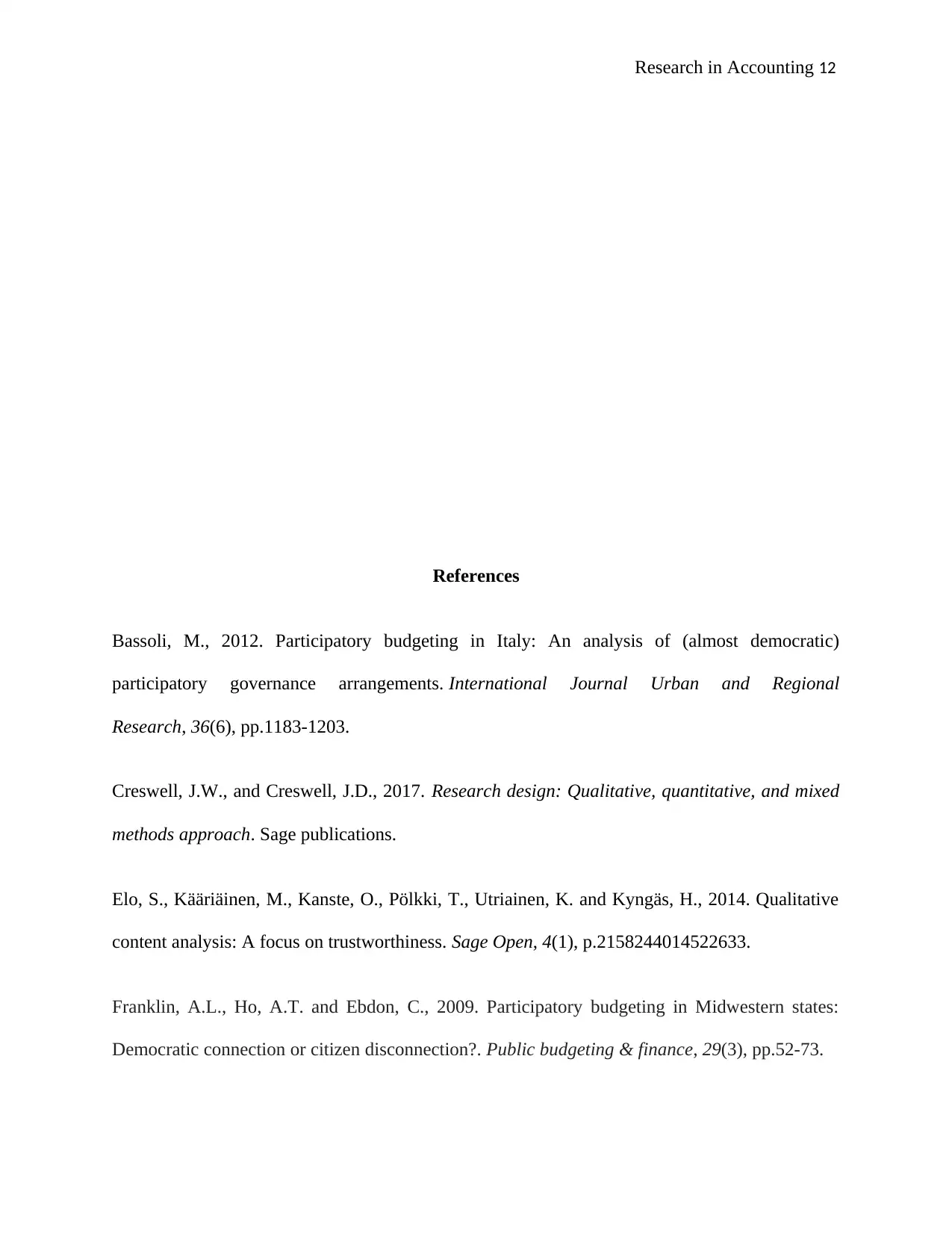
Research in Accounting 12
References
Bassoli, M., 2012. Participatory budgeting in Italy: An analysis of (almost democratic)
participatory governance arrangements. International Journal Urban and Regional
Research, 36(6), pp.1183-1203.
Creswell, J.W., and Creswell, J.D., 2017. Research design: Qualitative, quantitative, and mixed
methods approach. Sage publications.
Elo, S., Kääriäinen, M., Kanste, O., Pölkki, T., Utriainen, K. and Kyngäs, H., 2014. Qualitative
content analysis: A focus on trustworthiness. Sage Open, 4(1), p.2158244014522633.
Franklin, A.L., Ho, A.T. and Ebdon, C., 2009. Participatory budgeting in Midwestern states:
Democratic connection or citizen disconnection?. Public budgeting & finance, 29(3), pp.52-73.
References
Bassoli, M., 2012. Participatory budgeting in Italy: An analysis of (almost democratic)
participatory governance arrangements. International Journal Urban and Regional
Research, 36(6), pp.1183-1203.
Creswell, J.W., and Creswell, J.D., 2017. Research design: Qualitative, quantitative, and mixed
methods approach. Sage publications.
Elo, S., Kääriäinen, M., Kanste, O., Pölkki, T., Utriainen, K. and Kyngäs, H., 2014. Qualitative
content analysis: A focus on trustworthiness. Sage Open, 4(1), p.2158244014522633.
Franklin, A.L., Ho, A.T. and Ebdon, C., 2009. Participatory budgeting in Midwestern states:
Democratic connection or citizen disconnection?. Public budgeting & finance, 29(3), pp.52-73.
⊘ This is a preview!⊘
Do you want full access?
Subscribe today to unlock all pages.

Trusted by 1+ million students worldwide
1 out of 14
Related Documents
Your All-in-One AI-Powered Toolkit for Academic Success.
+13062052269
info@desklib.com
Available 24*7 on WhatsApp / Email
![[object Object]](/_next/static/media/star-bottom.7253800d.svg)
Unlock your academic potential
Copyright © 2020–2025 A2Z Services. All Rights Reserved. Developed and managed by ZUCOL.





